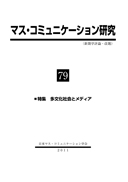Volume 79
Displaying 1-25 of 25 articles from this issue
- |<
- <
- 1
- >
- >|
Multicultural Society and Media Communication
-
Article type: Article
2011Volume 79 Pages 2-3
Published: July 31, 2011
Released on J-STAGE: October 06, 2017
Download PDF (991K) -
Article type: Article
2011Volume 79 Pages 5-25
Published: July 31, 2011
Released on J-STAGE: October 06, 2017
Download PDF (1153K) -
Article type: Article
2011Volume 79 Pages 27-44
Published: July 31, 2011
Released on J-STAGE: October 06, 2017
Download PDF (1149K) -
Article type: Article
2011Volume 79 Pages 45-61
Published: July 31, 2011
Released on J-STAGE: October 06, 2017
Download PDF (1150K) -
Article type: Article
2011Volume 79 Pages 63-84
Published: July 31, 2011
Released on J-STAGE: October 06, 2017
Download PDF (1161K) -
Article type: Article
2011Volume 79 Pages 85-108
Published: July 31, 2011
Released on J-STAGE: October 06, 2017
Download PDF (1326K)
Articles
-
Article type: Article
2011Volume 79 Pages 111-131
Published: July 31, 2011
Released on J-STAGE: October 06, 2017
Download PDF (2619K) -
Article type: Article
2011Volume 79 Pages 133-151
Published: July 31, 2011
Released on J-STAGE: October 06, 2017
Download PDF (1842K) -
Article type: Article
2011Volume 79 Pages 153-170
Published: July 31, 2011
Released on J-STAGE: October 06, 2017
Download PDF (1169K)
Workshop Reports
-
Article type: Article
2011Volume 79 Pages 171-172
Published: July 31, 2011
Released on J-STAGE: October 06, 2017
Download PDF (1093K) -
Article type: Appendix
2011Volume 79 Pages 173-
Published: July 31, 2011
Released on J-STAGE: October 06, 2017
Download PDF (1046K) -
Article type: Article
2011Volume 79 Pages 174-175
Published: July 31, 2011
Released on J-STAGE: October 06, 2017
Download PDF (1054K) -
Article type: Article
2011Volume 79 Pages 176-177
Published: July 31, 2011
Released on J-STAGE: October 06, 2017
Download PDF (1055K) -
Article type: Article
2011Volume 79 Pages 178-179
Published: July 31, 2011
Released on J-STAGE: October 06, 2017
Download PDF (1052K) -
Article type: Article
2011Volume 79 Pages 180-182
Published: July 31, 2011
Released on J-STAGE: October 06, 2017
Download PDF (1056K) -
Article type: Article
2011Volume 79 Pages 183-184
Published: July 31, 2011
Released on J-STAGE: October 06, 2017
Download PDF (1055K) -
Article type: Article
2011Volume 79 Pages 185-186
Published: July 31, 2011
Released on J-STAGE: October 06, 2017
Download PDF (1055K) -
Article type: Article
2011Volume 79 Pages 187-188
Published: July 31, 2011
Released on J-STAGE: October 06, 2017
Download PDF (1053K) -
Article type: Article
2011Volume 79 Pages 189-190
Published: July 31, 2011
Released on J-STAGE: October 06, 2017
Download PDF (1054K) -
Article type: Article
2011Volume 79 Pages 191-192
Published: July 31, 2011
Released on J-STAGE: October 06, 2017
Download PDF (1056K) -
Article type: Article
2011Volume 79 Pages 193-194
Published: July 31, 2011
Released on J-STAGE: October 06, 2017
Download PDF (1055K)
Research Group Records(December, 2010 to May, 2011)
-
Article type: Article
2011Volume 79 Pages 195-196
Published: July 31, 2011
Released on J-STAGE: October 06, 2017
Download PDF (1057K) -
Article type: Article
2011Volume 79 Pages 197-198
Published: July 31, 2011
Released on J-STAGE: October 06, 2017
Download PDF (1058K) -
Article type: Article
2011Volume 79 Pages 198-199
Published: July 31, 2011
Released on J-STAGE: October 06, 2017
Download PDF (1057K) -
Article type: Article
2011Volume 79 Pages 200-201
Published: July 31, 2011
Released on J-STAGE: October 06, 2017
Download PDF (1057K)
- |<
- <
- 1
- >
- >|
